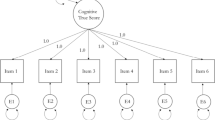Abstract
The concept of desirability is a means for complexity reduction of multivariate quality optimization. This paper provides a theoretical breakthrough regarding desirability indices, which application fields were formerly limited primarily by the lack of its distribution. Focussed are the distributions of Harrington’s desirability functions and different types of the desirability index.
Similar content being viewed by others
References
Averill AF., Ingram JM., Nolan RF. (2001). Optimising the selection of metal cleaning processes or cleaning agents using desirability functions. Trans Inst Metal Finishing 79(4):123–128
Ben-Gal I., Bukchin J. (2002). The ergonomic design of workstations using virtual manufacturing and response surface methodology. IEEE Trans 34:375–391
Castillo ED., Montgomery DC., McCarville DR. (1996). Modified desirability functions for multiple response optimization. J Qual Technol 28(3):337–344
Derringer GC., Suich D. (1980). Simultaneous optimization of several response variables. J Qual Technol 12(4):214–219
Harrington J. (1965). The desirability function. Ind Qual Control 21(10):494–498
Holland B., Ahsanullah M. (1989). Further results on the distribution of Meinhold and Singpurwalla. Am Stat 43(4):216–219
Johnson NL., Kotz S., Balakrishnan N. (1994). Continuous univariate distributions vol 1, 2nd edn. Wiley, New York
Kim K-J., Lin DKJ. (2000). Simultaneous optimization of mechanical properties of steel by maximizing desirability functions. Appl Stat 49(3):311–326
Mood AM., Graybill FA., Boes DC. (1974). Introduction to the theory of statistics 3rd edn. McGraw-Hill, Singapore
Schwartz SC., Yeh YS. (1982). On the distribution function and moments of power sums with log-normal components. Bell Syst Tech J 61(7):1441–1462
Steuer D. (2000). An improved optimisation procedure for desirability indices. Dortmund University, Germany
Trautmann H. (2004a). Qualitätskontrolle in der Industrie anhand von Kontrollkarten fünschbarkeitsindizes – Anwendungsfeld Lagerverwaltung. Dissertation, http://hdl.handle.net/2003/2794
Trautmann H. (2004b). The desirability index as an instrument for multivariate process control. Dortmund University, Germany
Trautmann H., Weihs C. (2004). Uncertainty of the optimum influence factor levels in multicriteria optimization using the concept of desirability. Technical Report 23/04, SFB 475, Dortmund University, Germany
Tuyev VV., Fedchenko PP. (1997). The study of soil humus changes with the harrington “desirability” function. Mapp Sci Remote Sens 34(4):264–272
Weber H., Weihs C. (2003). On the distribution of the desirability index using harrington’s desirability function. Statistics Department, Dortmund University, Germany
Wu W., Cui GH., Lu B. (2000). Optimization of multiple variables: application of central composite design and overall desirability. Chin Pharm J - Beijing 35(8):530–532
Author information
Authors and Affiliations
Corresponding author
Rights and permissions
About this article
Cite this article
Trautmann, H., Weihs, C. On the distribution of the desirability index using Harrington’s desirability function. Metrika 63, 207–213 (2006). https://doi.org/10.1007/s00184-005-0012-0
Received:
Accepted:
Published:
Issue Date:
DOI: https://doi.org/10.1007/s00184-005-0012-0




